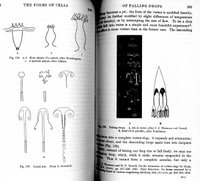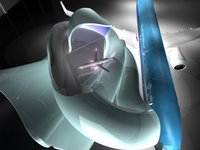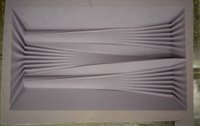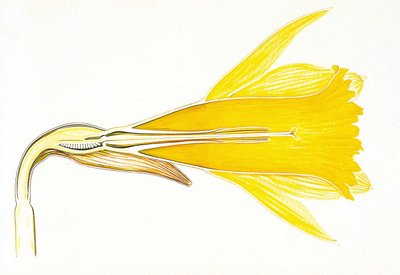Tuesday, October 31, 2006
Monday Lectures
This week's Monday night lecture was a principal from Office DA in Boston. Their work has a formal basis that breaks surfaces down to intricate geometric components. They also were doing a large urban project in Kuwait. Pretty sophisticated geometrically and materially, it outshone his meager lecture, http://www.officeda.com/
Saturday, October 28, 2006
Studio- Project Sources



Studio- Intake Experience



These are early renderings of the studio project which is a pavilion to present a Boeing 737 both for commercial and educational reasons. The theme of the studio is fluidity with this project focusing on air dynamics and the second project will focus on water. The scale of the project is intentionally between that of architecture and industrial design so new typologies of curvature are considered as well as manufacturing techniques (such as vacuum forming aluminum or plastic) that normally pertain to product design.
Tech- Presentation Boards

Friday, October 20, 2006
Tech- Vacuum Form Mold


Detail prototypes were due Monday. The vacuum-forming process can take a long time, having first to model and mill your mold then you have to pull it twice: once with ABS plastic to coat and protect it and a second time with PETG plastic for the final product. The mold is an expensive rigid foam that is milled with a three axis mill receiving input directly form the computer.
Lectures- Everywhere
UCLA: Our first lecture of the season was Peter Frankfurt, a partner at Imaginary Forces:
The lecture focused on their projects ranging from their start in film titles (begining with "seven") to what he called experience design which involved information and interface integrated with interior (mostly corporate) environments. they also worked with United Architects on the WTC competition, pushing the group to create storyboards and consider the project from the cinematic eye of the passerby on the sidewalk. The film they made is on the website: http://imaginaryforces.com/if.html
SCI-ARC: Wednesday night a few of us braved rush hour to hear Manuel De Landa speak about Gilles Deleuze and the Algorhytmic in Architecture. Hard to understand at first, it turned out to be eye-opening and very relevant to our technology class and its discourse on manifolds.
http://www.cddc.vt.edu/host/delanda/
BAY AREA: Jason Payne and Heather Roberge of Gnuform will be speaking at CCA October 23rd. I recommend going to all my friends in San Francisco. Jason was my summer studio professor and teaches my technology course this quarter. He has some interesting ideas about biology and bringing physics back to indexical architectural studies.
http://www.cca.edu/calendar/all/993
Saturday, October 14, 2006
TECH- Week 2 Boards

 Boards from last Friday's tech class included analysis of the botanical illustration (continued from previous week) as well as three iterations of proposals for translating selected forms and connections. We've focused on the twisting expansion of the petals from the stem as well petal topography and structure. Class consisted of group presentations and discussion of the week's reading on dynamic plant structures and similarities and differences to building statics. It was a great essay from Plant Biomechanics by Karl Niklas (chapter 7- The Mechanical Attributes of Organs). Next Friday, our first vacuum-formed pieces are due: mock-up of primary joints.
Boards from last Friday's tech class included analysis of the botanical illustration (continued from previous week) as well as three iterations of proposals for translating selected forms and connections. We've focused on the twisting expansion of the petals from the stem as well petal topography and structure. Class consisted of group presentations and discussion of the week's reading on dynamic plant structures and similarities and differences to building statics. It was a great essay from Plant Biomechanics by Karl Niklas (chapter 7- The Mechanical Attributes of Organs). Next Friday, our first vacuum-formed pieces are due: mock-up of primary joints.
Tuesday, October 10, 2006
Fall Theory Course
Opening distinctions:
MODERNISM=1900-1960, INTERNATIONAL, NATION STATES, EUROWESTERNIZATION, EXPERIENCE, SUBJECT/OBJECT, PHENOMENOLOGY, THINGS
POSTMODERNISM=1960-1990, MULTINATIONAL, CORPORATIONS, AMERICANIZATION, COMMUNICATION, READER/TEXT, SEMIOTICS:MEANING, IMAGES/TEXTS
SUPERMODERNISM=1990-PRESENT, GLOBALISM, MARKET STATE, PLANETARY, EXPERIENCE, SENSORY IMMERSION, AFFECT/MOOD, IMAGE AS THING
Summer Theory Course- book available
http://www.lulu.com/content/471187
Saturday, October 07, 2006
Research Studio- First Meeting
The project will be planning one of the satellite cities that is developing around the city of Madrid. The city is developing in a nodal, networking pattern similar to Los Angeles. In February we will travel to Madrid for a week to investigate the site, meet with the mayor and other city officials as well as meet with local architects like Rafael Moneo. The 14 students in the studio all seemed very excited by today's meeting as Thom is really into the project for this year and is devoting resources from Morphosis towards the endeavor.
Tech- Week 1
 For tech class, our chosen flower is the daffodil, scientific name narcissus pseudonarcissus. The class starts with a review of botanical drawings by early 20thc botanist Arthur Harry Church. We've begun with more of a biomimicry approach to the form and structure of the flower and will move to a more abstract project but maintain a precise language and detailing suited to the development of volume and joinery in vacuum-formed plastic.
For tech class, our chosen flower is the daffodil, scientific name narcissus pseudonarcissus. The class starts with a review of botanical drawings by early 20thc botanist Arthur Harry Church. We've begun with more of a biomimicry approach to the form and structure of the flower and will move to a more abstract project but maintain a precise language and detailing suited to the development of volume and joinery in vacuum-formed plastic.
